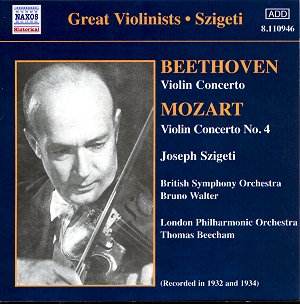What a range of transfer techniques Naxos seem to be
using. Having praised their Moiseiwitch and protested vigorously about
their Schnabel (Beethoven Concertos 3-5), praise seems in order here
again. Some swish remains and it sounds a little as if Mark Obert-Thornís
method is simply to put the discs on a period player with a fibre needle
and record them like that. If so, there could be worse ways of doing
it. Beechamís orchestra sounds a little crumbly but the violin is somehow
lifted from the context and has a wonderful speaking quality. Strangely,
the slightly earlier Beethoven recording is better still, with fuller
orchestral sound. Though I was born well into the LP era, there were
still people around in the late fifties who had only 78 equipment (just
as some today have not yet got into CDs) and this is the 78 sound as
I remember it.
The career of Joseph Szigeti (1892-1973) lasted a little
too long for its own good and in my college days his name was a by-word
for slovenly, swoopy, portamento-ridden playing. In vain did our elders
and betters tell us that his playing was far different in his prime,
but, as can be heard here, our elders and betters were quite right.
In terms of portamenti thereís not much to offend
modern ears and I can think of some present-day practitioners who might
well use more, even in Mozart and Beethoven. When I said above that
the recording gives his violin a wonderful speaking quality, it was
implicit that this quality came first of all from the violinist, and
it is above all for the very human, vocal manner of his playing that
these performances are valuable. I was surprised to find Tully Potter,
in his informative notes, turning critic and commenting that "Truth
to tell, Beecham, the supposed Mozart lover, serves up an accompaniment
that is brusque in some places and slapdash in others". Frankly,
I could only find admiration for the lightness of touch which with which
Beecham supports Szigeti in tempi which (especially in the last movement)
could all too easily have lapsed into heaviness. I think the main theme
in the last movement really is too slow for an Allegro, for all the
performersí grace, but otherwise this is a beautiful performance.
Iím not so sure about the Beethoven. Certainly, Szigetiís
speaking quality gives a meaning to many passages where it sometimes
seems that the violinist is practising his arpeggios while the orchestra
plays a tune, but it doesnít quite all add up. Both Szigeti and Walter
change tempi fairly freely, not necessarily at the same points with
the result that the first movement appears to be a rather sprawling
structure. On the other hand, they do seem to respond to each other
at least on a phrase-by-phrase basis and the performance has the spontaneity
and humanity for which both artists were renowned. Perhaps it is better
to view this as a snapshot of a great violinist playing the Beethoven
rather than a great performance of the Beethoven.
Myths are funny things. There are some early recordings
which really do seem not to have been matched artistically since, there
myths which require imaginative listening to understand what the fuss
was really about, there are others again which donít confirm their legendary
status at all. This is really none of these. It would seem to suggest
that fine performances then and fine performances now were not so unrecognisably
different. "Great performers" in the popular mind is sometimes
synonymous with "dead performers". Yet a comparison of this
with recent versions by, say Perlman (to choose one out of many) would
tend to suggest there is more community and continuity of feeling between
the public of the 1930s and our own nearly three-quarters of a century
later than we might suppose. And itís marvellous that such well-sounding
recordings exist to prove the point.
Christopher Howell

![]() Joseph SZIGETI (violin),
London Philharmonic Orch/Sir Thomas Beecham (1), British Symphony Orch/Bruno
Walter (2)
Joseph SZIGETI (violin),
London Philharmonic Orch/Sir Thomas Beecham (1), British Symphony Orch/Bruno
Walter (2) ![]() NAXOS Historical 8.110946
[66.56]
NAXOS Historical 8.110946
[66.56]